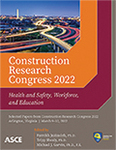Do OSHA 10/30-Hours Training Programs Revamp the Safety Attitudes of Construction Workers?
Publication: Construction Research Congress 2022
ABSTRACT
Safety attitude plays a major role in the safety performance of construction workers. Research has demonstrated that a positive safety attitude decreases the likelihood of workers’ unsafe behavior. Unsafe behavior is reportedly accountable for the majority of construction accidents. The construction industry, unfortunately, suffers from high rates of fatal and non-fatal accidents, and workers’ safety performance enhancement is essential to prevent accidents in workplaces. The Occupational Safety and Health Administration (OSHA) offers safety training, among which OSHA 10-h and OSHA 30-h programs are the most recognized and prevalent training. Extensive research studies have evaluated the effectiveness of such training programs. However, the impact of these outreach courses on the safety attitude of construction workers has not been investigated. Therefore, this article aims to examine the impact of OSHA 10/30-h construction training on the safety attitude. One-hundred and seventeen construction workers in the United States were recruited, and their safety attitude was measured using a standard questionnaire. Among the participants, 56 (48%) had participated in OSHA 10 and/or OSHA 30, and the rest of the workers asserted they did not attend such training courses. The results of the t-tests show a statistically significant difference among workers’ safety attitudes, indicating that OSHA 10/30-h training succeeded in changing the safety attitude of workers for the better (cognitive and behavioral). Given the importance of safety attitude, the study’s findings urge the safety trainers, professionals, and policymakers to incorporate safety attitude enhancement elements to OSHA 10/30 agendas and advance their training effectiveness to improve construction safety.
Get full access to this article
View all available purchase options and get full access to this chapter.
REFERENCES
Albert, A., Hallowell, M. R., Kleiner, B., Chen, A., and Golparvar-Fard, M. (2014). “Enhancing Construction Hazard Recognition with High-Fidelity Augmented Virtuality.” Journal of Construction Engineering and Management, American Society of Civil Engineers, 140(7), 04014024.
Albert, A., Hallowell, M. R., Skaggs, M., and Kleiner, B. (2017). “Empirical measurement and improvement of hazard recognition skill.” Safety Science, 93, 1–8.
Albert, A., Jeelani, I., and Han, K. (2020). “Developing hazard recognition skill among the next-generation of construction professionals.” Construction Management and Economics, Routledge, 0(0), 1–16.
Caban-Martinez, A. J., Santiago, K. M., Stillman, J., Moore, K. J., Sierra, D., Chalmers, J., Baniak, M., and Jordan, M. M. (2018). “Physical Exposures, Work Tasks and OSHA-10 Training among Temporary and Payroll Construction Workers.” Journal of occupational and environmental medicine, 60(4), e159–e165.
Garcia, P. (2018). “OSHA-30 Lab Topics Course on Construction Safety and Hazard Identification.” Construction Management.
Hallowell, M. (2010). “Safety risk perception in construction companies in the Pacific Northwest of the USA.” Construction Management and Economics, Routledge, 28(4), 403–413.
Jeelani, I. (2019). Improving Safety Performance in Construction Using Visual Data Analytics and Virtual Reality. Ph.D., North Carolina State University, United States -- North Carolina.
Kashmiri, D., Taherpour, F., Namian, M., and Ghiasvand, E. (2020). Role of Safety Attitude: Impact on Hazard Recognition and Safety Risk Perception. American Society of Civil Engineers, 583–590.
Langford, D., Rowlinson, S., and Sawacha, E. (2000). “Safety behaviour and safety management: its influence on the attitudes of workers in the UK construction industry.” Engineering, Construction and Architectural Management, MCB UP Ltd, 7(2), 133–140.
Li, M., Zhai, H., Zhang, J., and Meng, X. (2020). “Research on the Relationship Between Safety Leadership, Safety Attitude and Safety Citizenship Behavior of Railway Employees.” International Journal of Environmental Research and Public Health, Multidisciplinary Digital Publishing Institute, 17(6), 1864.
Loosemore, M., and Malouf, N. (2019). “Safety training and positive safety attitude formation in the Australian construction industry.” Safety Science, 113, 233–243.
Mathiasen, L., Morley, K., Chapman, B., and Powell, D. (2012). “Using a Training Video to Improve Agricultural Workers’ Knowledge of On-Farm Food Safety.” Journal of Extension, 50(1).
Namian, M., Albert, A., and Feng, J. (2018). “Effect of Distraction on Hazard Recognition and Safety Risk Perception.” Journal of Construction Engineering and Management, 144(4), 04018008.
Namian, M., Albert, A., Zuluaga, C. M., and Behm, M. (2016a). “Role of Safety Training: Impact on Hazard Recognition and Safety Risk Perception.” Journal of Construction Engineering and Management, American Society of Civil Engineers, 142(12), 04016073.
Namian, M., Taherpour, F., Ghiasvand, E., and Turkan, Y. (2021). “Insidious Safety Threat of Fatigue: Investigating Construction Workers’ Risk of Accident Due to Fatigue.” Journal of Construction Engineering and Management, American Society of Civil Engineers, 147(12), 04021162.
Namian, M., Zuluaga, C. M., and Albert, A. (2016b). “Critical Factors That Impact Construction Workers’ Hazard Recognition Performance.” Construction Research Congress 2016, American Society of Civil Engineers, San Juan, Puerto Rico, 2762–2772.
OSHA (Occupational Safety and Health Administration). (2018). “Commonly Used Statistics | Occupational Safety and Health Administration.” <https://www.osha.gov/data/commonstats>(May 28, 2020).
“OSHA Outreach Training Program - Construction Industry | Occupational Safety and Health Administration.” (2019). <https://www.osha.gov/dte/outreach/construction/>(Jun. 8, 2021).
Shin, M., Lee, H.-S., Park, M., Moon, M., and Han, S. (2014). “A system dynamics approach for modeling construction workers’ safety attitudes and behaviors.” Accident Analysis & Prevention, Systems thinking in workplace safety and health, 68, 95–105.
US Bureau of Labor Statistics. (2019). “Census of Fatal Occupational Injuries (CFOI) - Current and Revised Data.” <https://www.bls.gov/iif/oshcfoi1.htm>(Jun. 9, 2020).
Wilkins, J. R. (2011). “Construction workers’ perceptions of health and safety training programmes.” Construction Management and Economics, Routledge, 29(10), 1017–1026.
Information & Authors
Information
Published In
History
Published online: Mar 7, 2022
Authors
Metrics & Citations
Metrics
Citations
Download citation
If you have the appropriate software installed, you can download article citation data to the citation manager of your choice. Simply select your manager software from the list below and click Download.
